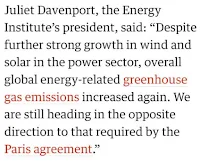Black Step Deux: The Biochar Academy
"We have historical examples where significant carbon was withdrawn from the atmosphere by human activity, resulting in global climate response and regional cooling."
In the previous installment, I described my first day’s lecture at the Biochar Academy in Canandaigua NY. That first part was about the need for change. Many people already feel it, but many more hesitate. This time I am going to focus on what you can do once you realize that not only is there a problem, but unless you and everyone around you starts to take action instantly, you are all going to die.
When you take the black step, the friendships you make are deep ones. Many will last a lifetime. You are all striving to make that life long and happy. You are the Watchers on the Wall. You are black step bodhisattvas. You are Gandy Dancers and Shanty-men.
In 2014, the Intergovernmental Panel on Climate Change issued their Fifth Assessment Report concluding that reducing or completely stopping fossil fuel emissions will not save us from climate change.
It will just hold us at the level of heating and disruption already in the pipeline.
IPCC conceded that more renewables are a great idea. They just don’t reverse climate change. Curtailing emissions will only slow, not stop, climate change.
In 2014, these several thousand scientists reached a contentious consensus and then went out and told the world that only carbon dioxide removal (and similar steps to increase solar reflectivity, rebuild ecosystems, and restore the marine environment) will undo the damage to Earth’s carbon cycle and stop climate change.
 More recently, James Hansen and 17 co-authors have quantified the need in a scientific paper still undergoing review, Global Warming in the Pipeline.
They conclude that without mitigation steps like CO2 drawdown, we have
10 degrees of warming baked in the cake. If we stopped emitting today,
the aerosol cooling effect would abruptly stop and we would go up by 3
degrees virtually overnight, as nearly happened when planes were
grounded following the 911 attack. Because of tipping points, 3 would
lead to 4, 4 would lead to 5, and so on. At some level a new equilibrium
would be reached, known as Hothouse Earth.
Humans, as with all vertebrate mammals, would not still be around for
that part. We would have boarded the dark ships and gone into the West
with the Elves.
More recently, James Hansen and 17 co-authors have quantified the need in a scientific paper still undergoing review, Global Warming in the Pipeline.
They conclude that without mitigation steps like CO2 drawdown, we have
10 degrees of warming baked in the cake. If we stopped emitting today,
the aerosol cooling effect would abruptly stop and we would go up by 3
degrees virtually overnight, as nearly happened when planes were
grounded following the 911 attack. Because of tipping points, 3 would
lead to 4, 4 would lead to 5, and so on. At some level a new equilibrium
would be reached, known as Hothouse Earth.
Humans, as with all vertebrate mammals, would not still be around for
that part. We would have boarded the dark ships and gone into the West
with the Elves.
Ultimately we will need to find our way beyond zero goals. Carbon neutrality will not be good enough. Most of the calculations in Marrakech, Bonn, Madrid, Glasgow, Sharm El Sheikh, and Dubai assume that emissions will exceed targets, and the need will be for a drawdown to remove those emissions, sometime in the future. This is a dangerous gamble. We are running out of road to kick the can down.
We have 2000 gigatons (2 trillion tons) of excess greenhouse gases (CO2e) in the atmosphere and ten times that in the ocean. As we withdraw from the atmosphere any of that excess, the ocean will try to equilibrate by off-gassing. To get back to pre-industrial concentrations in the atmosphere we will need to draw down approximately 3.5 trillion tons. If we could drop concentration by 1 gigaton per year, that would take us 3500 years. If we can net remove 10 Gt/y it would take 350 years. At 50 Gt/y drawdown would restore the climate of the recent Holocene epoch during which our civilization evolved in 70 years. Kathleen Draper and I showed in our 2018 book, Burn, how biochar alone can actually accomplish that at a negative cost.
 Of
course, biochar is not the only solution. There are hundreds. But
biochar markets already operating now are quickly scaling to take 5–10
GtC out every year just from agriculture — converting crop wastes into
fertilizers. Reforestation of available degraded lands could take still
more. Kelp farms in the ocean will rebuild fish stocks, absorb carbon
and make food and fuel.
Of
course, biochar is not the only solution. There are hundreds. But
biochar markets already operating now are quickly scaling to take 5–10
GtC out every year just from agriculture — converting crop wastes into
fertilizers. Reforestation of available degraded lands could take still
more. Kelp farms in the ocean will rebuild fish stocks, absorb carbon
and make food and fuel.
This image shows afforestation/reforestation meeting the criteria of no farmland or parkland conversion, no food vs fuel controversy, respecting smallholders and indigenous peoples, attention to albedo, suitable soil types, etc.
 The
darling of the Biden Infrastructure Bill is Direct Air Capture, or what
I like to call artificial trees. The USA is throwing more billions of
dollars at this than any other CDR technology. But it has two Achilles
Heels: materials with which to make the amide chemicals used to extract
carbon from the air, and energy to heat the reaction and run the fans.
Removing just 2% of present annual emissions this way would require more
than half of all the power the world generates today. This has rather
profound social and ecological implications.
The
darling of the Biden Infrastructure Bill is Direct Air Capture, or what
I like to call artificial trees. The USA is throwing more billions of
dollars at this than any other CDR technology. But it has two Achilles
Heels: materials with which to make the amide chemicals used to extract
carbon from the air, and energy to heat the reaction and run the fans.
Removing just 2% of present annual emissions this way would require more
than half of all the power the world generates today. This has rather
profound social and ecological implications.
By the way, a tree does it for free, and you can eat the fruit and nuts while it does.
I worry about the direction Europe has taken with plantation biomass for energy, or BECCS. A monoculture plantation is not a forest ecology. It comes at the expense of ecology. David Wallace-Wells says that “to achieve even what is asked of BECCS in the Paris accords would require using a third of the world’s farmable land. An article in Nature Climate Change said it is “difficult to reconcile with planetary boundaries” — that is, deploying BECCS at scale would impose such devastating costs in terms of forest cover, biodiversity, agriculture, and freshwater that doing so “might undermine the stability and resilience of the earth system.”
Rock weathering is another good tool. Suitable and readily available mineral silicates far exceed requirements for sequestering all conceivable anthropogenic CO2 emissions. Rock weathering is the major source of most plant nutrients. Depending on the degree to which soils have lost nutrients from leaching and crop export, it is economically beneficial for farmers and herders to amend soils with rock powders that will slowly release natural materials for decades. These can provide all the nutrient elements plants need except for nitrogen and make them directly available to plant root mycorrhizae. Mixed with biochar to retain nutrients and water, they become slow, time-release fertilizers. And like biochar, remineralization can be sustained at scale.
 |
With this new perspective, a world of opportunity opens in terms of how and to what degree biochar can displace materials that either have a large carbon footprint, are non-renewable, are toxic, or are simply too expensive. By carbonizing underutilized waste streams, biochar can help many industries to meet their decarbonization targets and also tick many of the boxes for the UN’s Sustainable Development Goals.
I was tempted to place a paywall right here, but instead am letting this continue on for free. I only ask that readers who feel they could spare a buck or two to support me, please consider subscribing to The Great Change. Thanks.
So let’s take a moment and mention adoption. How does something go viral? The obstacle is not technology. The obstacle is human culture. One idea is to make biochar cool.
Is it possible to unscrew the pooch? Yes. The impediments are cultural, not technical. In his book, The Tipping Point, Malcolm Gladwell gave us three rules for what goes viral:
- The Law of the Few. Margaret Mead said, “Never believe that a few caring people can’t change the world. For, indeed, that’s all who ever have.” A small number of “influencers” have outsized effects. Gladwell calls them “mavens.” Effective climate action needs a few more than it has now.
- Stickiness. This is the Cool concept — we need music, poems, or catchy phrases that attach to people’s neural circuits like a bad jingle (think: Cars for Kids)
- Context. The context is what confers urgency. Climate change should be thought of as World War II c. 1940, and we need to mobilize, like yesterday. It is an emergency. It is not a problem for a future administration or generation. A study published in Nature Sustainability last week warned that ecological tipping points could occur much sooner than expected. These are what are coming to be called “doom loops.” We know there are tipping points and some of them are near-term extinction events, but we just don’t know where or when we may hit them.
The context is that it is time to stop arguing and start acting. It is actually past that time. We need to act urgently.
 There is no avoiding a very significant redesign for our global civilization.
In a very short time, it will require a shift of global industrial
economies no less profound than that which transformed Western and
Soviet manufacturing in 1940. For the owners of factories, steel mills,
mines, and myriad enterprises, a paradigm shift will have to transform
their holdings from carbon polluting to carbon trapping almost
overnight. In 1940, entire industrial economies switched instantly from
producing consumer goods to providing war materials. It was a rational
response to a visceral threat.
There is no avoiding a very significant redesign for our global civilization.
In a very short time, it will require a shift of global industrial
economies no less profound than that which transformed Western and
Soviet manufacturing in 1940. For the owners of factories, steel mills,
mines, and myriad enterprises, a paradigm shift will have to transform
their holdings from carbon polluting to carbon trapping almost
overnight. In 1940, entire industrial economies switched instantly from
producing consumer goods to providing war materials. It was a rational
response to a visceral threat.
We have lots of examples. Covid should have taught us that when the world faces an immediate and devastating threat, budgets no longer matter. Trillions of dollars suddenly appear, as if by magic. Apollo-11 suffered a catastrophic explosion on its way to the moon, slowly leaking the oxygen the astronauts needed to survive. The brain trust at Houston Control went to work and designed what had to be done to get them home safely.
While actions by governments in support of these initiatives is important, it is our conclusion that the initiative must come from the bottom up. We suggest this can only be accomplished by incentives such as meeting basic needs and the profit motive. The principal impediment is not human technological prowess. The impediment is cultural inertia, which is, to a significant extent, biologically dictated.
— IPCC
When a tanker-truck collision with an overpass melted the bridge and closed a stretch of interstate highway that carries 150,000 vehicles every day, Pennsylvania Governor Josh Shapiro predicted it would take months to fully restore the road. State transportation engineers devised a temporary six-lane road made of a recycled glass aggregate and sped up the curing by borrowing a vehicle ordinarily used to dry racing tracks after rain. Civil engineers, laborers, and carpenters worked around the clock to address the emergency. The road reopened in just 12 days.
When it comes to climate change, consider what the alternative is to not addressing it, or not treating it as an emergency. The most recent IPCC 2023 Synthesis Report offered this image. A person born in 1950 is 73 today. They will see very little climate change in their remaining lifetime. A person born in 2023 will be 73 in 2096. For them, it will be an entirely different world.

Simon Willcock from Rothamsted and Bangor University, who co-led the “doom loop” study published in Nature Sustainability said,
In the past two years, the world has come together around the climate and ecological crises through the UN Climate Change and Biodiversity Conferences. But we should remember that the causes of the crises are interlinked — that they have already collided — and that inaction over both may result in dire consequences.
Another of the paper’s co-authors, John Dearing, Emeritus Professor at the University of Southampton added,
Previous studies of ecological tipping points suggest significant social and economic costs from the second half of the 21st century onwards. Our findings suggest the potential for these costs to occur much sooner.
People get ready, there’s change a-coming.
References
Bergman, A. & A. Rinberg (2021) “The Case for Carbon Dioxide Removal: From Science to Justice” CDR Primer, edited by J Wilcox, B Kolosz, J Freeman.
Kamal Baharin, Nur Syahirah, et al. “Impact and effectiveness of Bio-Coke conversion from biomass waste as alternative source of coal coke in Southeast Asia.” Journal of Material Cycles and Waste Management 25.1 (2023): 17–36.
Willcock, S. et al, Earlier collapse of Anthropocene ecosystems driven by multiple faster and noisier drivers, Nature Sustainability (2023). DOI: 10.1038/s41893–023–01157-x.
Wen, Jiehuizi, et al. “New insights into the green cement composites with low carbon footprint: The role of biochar as cement additive/alternative.” Resources, Conservation and Recycling 197 (2023): 107081.
Meanwhile, let’s end this war. Towns, villages, and cities in Ukraine are being bombed every day. Ecovillages and permaculture farms have organized something like an underground railroad to shelter families fleeing the cities, either on a long-term basis or temporarily, as people wait for the best moments to cross the border to a safer place or to return to their homes if that becomes possible. There are 70 sites in Ukraine and 500 around the region. As you read this, we are sheltering some 2,000 adults and 450 children. We call our project “The Green Road.”
For most of the children refugees, this will be their first experience in ecovillage living. They will directly experience its wonders, skills, and safety. They may never want to go back. Those that do will carry the seeds within them of the better world they glimpsed through the eyes of a child.
Those wishing to make a tax-deductible gift can do so through Global Village Institute by going to http://PayPal.me/greenroad2022 or by directing donations to greenroad@thefarm.org.
There is more info on the Global Village Institute website at https://www.gvix.org/greenroad or read this recent article in Mother Jones. Thank you for your help.
The COVID-19 pandemic destroyed lives, livelihoods, and economies. But it has not slowed climate change, a juggernaut threat to all life, humans included. We had a trial run at emergency problem-solving on a global scale with COVID — and we failed. 6.9 million people, and counting, have died. We ignored well-laid plans to isolate and contact trace early cases; overloaded our ICUs; parked morgue trucks on the streets; incinerated bodies until the smoke obscured our cities as much as the raging wildfires. The modern world took a masterclass in how abysmally, unbelievably, shockingly bad we could fail, despite our amazing science, vast wealth, and singular talents as a species.
Having failed so dramatically, so convincingly, with such breathtaking ineptitude, do we imagine we will now do better with climate? Having demonstrated such extreme disorientation in the face of a few simple strands of RNA, do we imagine we can call upon some magic power that will arrest all our planetary-ecosystem-destroying activities?As the world emerges into pandemic recovery (maybe), there is growing recognition that we must learn to do better. We must chart a pathway to a new carbon economy that goes beyond zero emissions and runs the industrial carbon cycle backward — taking CO2 from the atmosphere and ocean, turning it into coal and oil, and burying it in the ground. The triple bottom line of this new economy is antifragility, regeneration, and resilience. We must lead by good examples; carrots, not sticks; ecovillages, not carbon indulgences. We must attract a broad swath of people to this work by honoring it, rewarding it, and making it fun. That is our challenge now.
Help me get my blog posted every week. All Patreon donations and Blogger or Substack subscriptions are needed and welcomed. You are how we make this happen. Your contributions are being made to Global Village Institute, a tax-deductible 501(c)(3) charity. PowerUp! donors on Patreon get an autographed book off each first press run. Please help if you can.
Thank you for reading The Great Change.







Comments